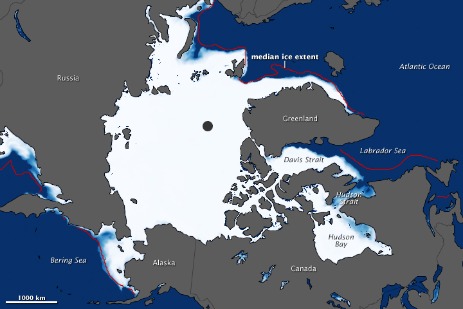 Click for a larger version.Image: NASAArctic sea ice extent averaged over Januray 2011 its lowest recorded levels since satellite records began in 1979. It was 19,300 square miles below the record low of 5.25 million square miles, set in 2006, and 490,000 square miles below the 1979 to 2000 average.
Click for a larger version.Image: NASAArctic sea ice extent averaged over Januray 2011 its lowest recorded levels since satellite records began in 1979. It was 19,300 square miles below the record low of 5.25 million square miles, set in 2006, and 490,000 square miles below the 1979 to 2000 average.
Climate change, the crisis many hoped we could ignore for decades, is here. Ice and snow that covered the vast frozen northland for 800,000 years is disappearing rapidly. As countless square miles of the Arctic turn from reflective white to heat-absorbing dark, the result is an acceleration of global warming. And this is not just a problem for polar bears. The Arctic acts as the air conditioner for the entire planet. And it is starting to break down.
A coauthor and I estimated the economic impacts of this breakdown [PDF]. What is the price of a melting Arctic? Trillions of dollars in global economic damages.
The Arctic is warming twice as fast as the rest of the planet. As a result, every summer, more and more Arctic Sea ice is lost. As soon as the 2030’s, according to some recent estimates, the ice that until recently blanketed the summer Arctic Ocean will be completely replaced with blue-black waters. Further south, the Arctic winter is rapidly getting shorter, and white snow is being replaced by dark tundra.
In addition to this “albedo change,” there is another critical feedback from Arctic melting in the climate system. As the snow disappears, the underlying frozen tundra, or permafrost, is melting too. This is releasing carbon trapped in the soils, mostly in the form of methane gas, a powerful global warming pollutant.
The findings from our study are alarming. Compared to its pre-industrial state, every year, the melting Arctic is already heating the planet at a rate equal to 42 percent of U.S. global warming pollution — comparable to the emissions from 500 coal-fired power plants. By the end of the century, the melting Arctic may itself become a bigger source of global warming then the biggest economies in the world.
Economists have begun to calculate the costs that global warming is starting to cause — through rising sea levels, heat waves, droughts, impacts on food production — costs that will rise dramatically as the planet heats up. Warming caused today will contribute to damages for decades to come. Using government figures from the U.S. and U.K. for the costs of additional global warming, our study provides a preliminary estimate of the costs of a melting Arctic.
Costs caused by the additional warming, this year alone, are in the range of $61-$371 billion. By 2050, at the low end, we calculate the damages from the melting Arctic will be $2.5 trillion. The analysis projects likely damages in the tens of trillions by the end of the century.
This is yet another sobering warning of the high costs of unchecked climate change-costs that will be borne by homeowners, businesses, farmers, and cities and towns. It is also a reminder that half-measures on global warming will do little good. Without action to slow the warming soon, the Arctic air conditioner may well break down completely, and overwhelm any half-hearted attempts to turn down the heat on an overheating planet.
Sheila Watt-Cloutier, an Inuit leader and Nobel Peace Prize nominee said of our study: “This is more evidence of how all things connect. We know well how global warming is causing the sea ice and snow to melt, jeopardizing our way of life. Now, we can see how the melting Arctic is imposing similar costs on people across the planet.” Check out Reuters coverage of the study here.



